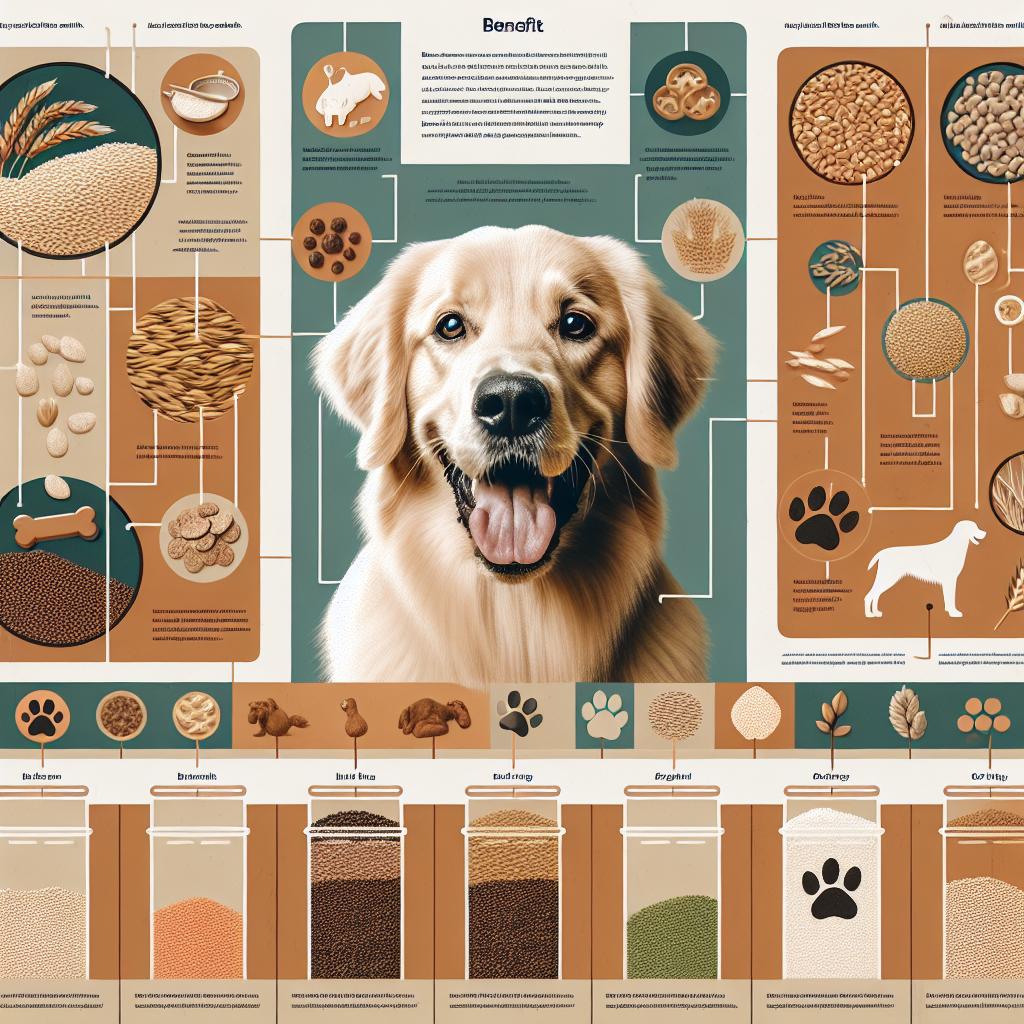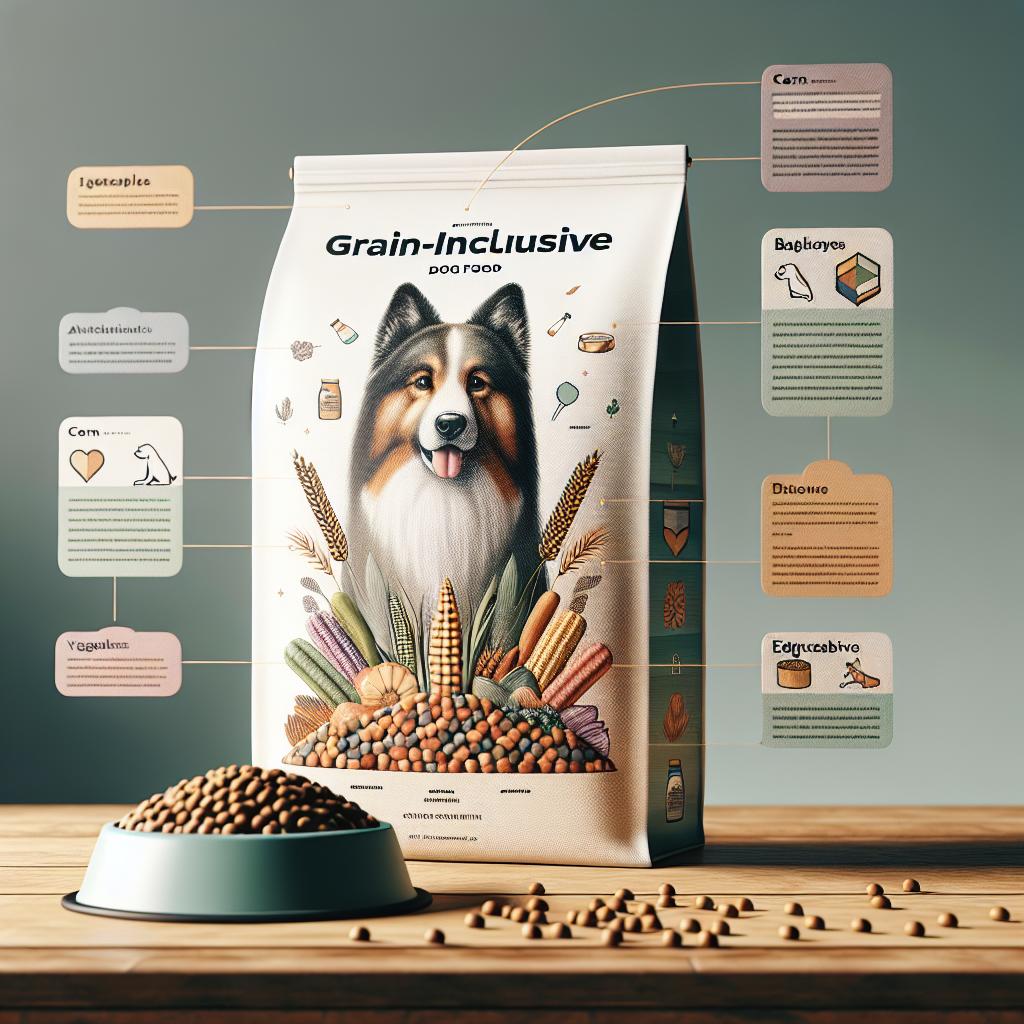Understanding the Benefits of Grain-Inclusive Dog Food
In a world where pet nutrition trends can swing like a pendulum, understanding what truly nourishes our canine companions can feel overwhelming. With a myriad of choices ranging from grain-free to grain-inclusive formulas, pet owners often find themselves at a crossroads, contemplating what is best for their furry friends. While the allure of grain-free diets has gained significant popularity in recent years, grain-inclusive dog food continues to offer countless benefits that deserve exploration. In this article, we delve into the nutritional landscape of grain-inclusive dog food, shedding light on its advantages and debunking common myths. By unraveling the science of canine nutrition, we aim to provide pet owners with the insights necessary to make informed dietary choices, ensuring that every tail-wagging companion remains healthy, happy, and full of life.
Exploring the Nutritional Value of Grains in Canine Diets
When considering a balanced diet for dogs, the inclusion of grains can offer significant nutritional benefits. Whole grains, such as brown rice, quinoa, and oats, provide a wealth of essential nutrients, including complex carbohydrates, vitamins, and minerals. These carbohydrates serve as a primary energy source, supporting an active lifestyle and maintaining overall vitality. Furthermore, whole grains are a rich source of dietary fiber, promoting healthy digestion and helping to regulate blood sugar levels, which is particularly beneficial for dogs predisposed to obesity or diabetes.
In addition to their energy-providing properties, grains contribute to a dog’s diet by offering a variety of important nutrients:
- B Vitamins: Essential for energy production, brain health, and nervous system function.
- Minerals: Such as iron and magnesium, critical for muscle function and overall health.
- Antioxidants: Found in certain grains, supporting the immune system and combating oxidative stress.
| Grain | Nutrient Highlights |
|---|---|
| Brown Rice | Fiber, B Vitamins |
| Oats | Antioxidants, Magnesium |
| Quinoa | Complete Protein, Iron |
Choosing a high-quality grain-inclusive dog food can provide these vital nutrients while ensuring your pet enjoys a varied and satisfying diet. It is essential to consider individual dietary needs, as certain dogs may thrive on grain-based diets while others with sensitivities might require alternatives. Ultimately, understanding the role of grains in canine nutrition can help pet owners make informed choices that contribute to their dog’s long-term health and well-being.

Highlighting the Digestive Benefits of Grain-Inclusive Formulations
Grain-inclusive formulations offer a variety of digestive benefits for dogs, promoting a healthier gut and overall well-being. The inclusion of wholesome grains such as brown rice, oatmeal, and barley provides essential carbohydrates that are easily digestible and serve as an excellent source of energy. These grains also contribute to a balanced diet by ensuring the presence of vital nutrients, including vitamins and minerals. Additionally, the fiber content found in whole grains plays a significant role in maintaining digestive health, helping to regulate bowel movements and prevent gastrointestinal issues.
High-fiber grains can also foster the growth of beneficial gut bacteria, which further aids in digestion and nutrient absorption. This symbiotic relationship enhances the overall digestive process, allowing dogs to break down food more effectively. Furthermore, grain-inclusive diets can lead to improved hydration levels, as many grains absorb water during digestion, keeping the gut moist and functioning optimally. When choosing grain-inclusive dog food, pet owners can look for options that combine a variety of grains along with high-quality proteins to create a comprehensive and nourishing meal
| Grain Type | Digestive Benefit |
|---|---|
| Brown Rice | Easy to digest, provides energy |
| Oatmeal | High fiber, helps regulate bowel movements |
| Barley | Prebiotic properties, supports healthy gut bacteria |

Identifying Quality Ingredients for Optimal Health
When it comes to choosing grain-inclusive dog food, it’s crucial to focus on the quality of the ingredients to ensure your furry friend receives the best possible nutrition. Look for brands that prioritize natural, whole foods rather than fillers or artificial additives. Recognizing high-quality protein sources is essential; options like chicken, beef, and fish should be prominently listed among the first ingredients. Additionally, consider the inclusion of beneficial grains such as brown rice, quinoa, and oats, which can provide essential vitamins and fibers for optimal digestion.
To further evaluate the quality of dog food, it’s helpful to understand the significance of sourcing transparency and nutritional balance. Research brands that provide clear information about where their ingredients come from and how they are processed. Here’s a quick checklist of aspects to consider:
- Ingredient Sources: Opt for brands that specify local or farm-sourced ingredients.
- Preservatives: Avoid foods with artificial preservatives; look for natural preservatives like mixed tocopherols.
- Omega Fatty Acids: Ingredients like fish oil or flaxseed can promote healthy skin and coat.
| Ingredient | Benefit |
|---|---|
| Brown Rice | Rich in fiber; aids digestion |
| Chicken Meal | Concentrated source of protein |
| Peas | High in protein and vitamins |
| Sweet Potatoes | Excellent source of carbohydrates and beta-carotene |

Tailoring Grain-Inclusive Choices for Specific Breed Needs
When selecting grain-inclusive options for dogs, it’s essential to understand that different breeds have unique nutritional needs. Depending on their size, energy levels, and potential health concerns, you can tailor these grain-inclusive choices to ensure optimal health. For instance, smaller breeds often benefit from a higher caloric density, making brown rice, oats, or quinoa excellent sources of energy while being easily digestible. In contrast, larger breeds might require a grain-inclusive formula that enhances joint health with ingredients like barley or whole wheat that provide slower-releasing carbohydrates, promoting steady energy levels without overwhelming their systems.
Additionally, certain breeds may have predispositions to specific health issues that grain-inclusive diets can address. For example, breeds prone to digestive problems, such as Bulldogs or Boxers, may thrive on formulas that include sweet potatoes or ef grains like millet which are known for their soothing effects on the gut. A useful approach is to consider a comparison of different grain-inclusive dog foods based on breed needs. The following table summarizes key grain ingredients and their benefits:
| Grain Ingredient | Benefits | Best for Breeds |
|---|---|---|
| Brown Rice | High in fiber, promotes healthy digestion | Small breeds, puppies |
| Oats | Rich in antioxidants, helps with allergies | Breeds with sensitive skin |
| Quinoa | Complete protein source, high in essential amino acids | Active breeds requiring muscle maintenance |
| Barley | Supports weight management, low glycemic index | Large breeds, overweight dogs |
| Millet | Easy to digest, contains phosphorus and magnesium | Dogs with sensitive stomachs |
Q&A
Q&A: Understanding the Benefits of Grain-Inclusive Dog Food
Q1: What exactly is grain-inclusive dog food?
A1: Grain-inclusive dog food is precisely what it sounds like—pet food that includes grains as part of its ingredient list. While some dog food options focus solely on high-protein ingredients and exclude grains (often labeled as grain-free), grain-inclusive formulas often feature wholesome grains like brown rice, oats, and barley, providing a well-rounded nutrition profile for your furry friend.
Q2: What are some common grains found in these dog foods?
A2: You’ll often find grains such as brown rice, oatmeal, quinoa, barley, and millet in grain-inclusive dog foods. These grains not only serve as a source of carbohydrates but also contribute to the overall health of your dog through additional nutrients and fiber.
Q3: What benefits do grains provide for my dog?
A3: Grains can be a valuable source of energy! They offer carbohydrates that help fuel your dog’s daily activities. Additionally, many grains come packed with beneficial nutrients, including B vitamins, iron, and antioxidants. The fiber content found in grains supports digestive health and can assist in maintaining a healthy weight.
Q4: Are there any misconceptions about grain-inclusive dog food?
A4: Absolutely! One common misconception is that all grains are bad for dogs. While some dogs may have specific sensitivities or allergies to certain grains, the majority can digest and benefit from them. Grain-inclusive foods can also contain significant amounts of protein and essential fatty acids, which are vital for a dog’s overall wellness.
Q5: How do I know if grain-inclusive dog food is right for my pet?
A5: Choosing the right food for your dog typically involves observing their specific dietary needs, health status, and activity levels. Consulting with your veterinarian is key—they can provide tailored advice based on your dog’s individual health profile. If your pet thrives on grain-inclusive food and shows no signs of allergies, it might be an excellent fit for them!
Q6: Can grain-inclusive food help with specific health issues in dogs?
A6: Yes, it can! Depending on the grains used, grain-inclusive dog food can benefit dogs with certain health issues. For instance, fiber-rich grains can support healthy digestion and regulate blood sugar levels. Always consult with a veterinarian if your dog has specific health concerns that might be impacted by their diet.
Q7: What should I look for when selecting grain-inclusive dog food?
A7: When selecting grain-inclusive dog food, look for high-quality ingredients. It’s best to choose products that list a high-quality protein source at the top of the ingredient list, while ensuring that the grains included are whole and minimally processed. Checking for a balance of vitamins, minerals, and healthy fats is equally important.
Q8: Are there any potential downsides to grain-inclusive dog food?
A8: While grain-inclusive dog food is generally safe for most dogs, it’s crucial to monitor your pet for any signs of food allergies or sensitivities. Some dogs may experience gastrointestinal upset if they are not accustomed to grains. Gradually transitioning to a new food and observing your pet’s reaction is always advisable.
Q9: why might a pet owner choose grain-inclusive dog food?
A9: A pet owner might choose grain-inclusive dog food to provide their canine companion with a balanced diet, ensuring they receive a mix of nutrients, fiber, and energy sources. With proper research and consultation with a veterinarian, grain-inclusive diets can be an excellent choice for promoting overall health and vitality in dogs.
Q10: Where can I find reliable grain-inclusive dog food options?
A10: You can find grain-inclusive dog food at your local pet store, online retailers, and through veterinary practices. Always ensure you’re purchasing from reputable brands that adhere to high manufacturing standards to ensure quality and safety for your pet. Happy feeding!
Wrapping Up
In closing, the journey into the world of grain-inclusive dog food unveils a tapestry of nutrition and care designed to enhance your canine companion’s well-being. From supporting digestive health to providing essential energy, these formulations are crafted with an understanding of both the dietary needs and preferences of our furry friends. As you consider the best options for your pet’s diet, remember that each dog is unique; what works for one may not suit another. By embracing the benefits of grain-inclusive varieties, you can make informed decisions that promote a happy, healthy life for your beloved pooch. Ultimately, the key lies in balancing quality ingredients with your pet’s individual needs, fostering a deeper bond through mindful nourishment. So, whether embarking on a new feeding journey or fine-tuning an existing routine, your quest for the perfect bowl of nourishment continues—may it be filled with care, health, and tail-wagging satisfaction.

